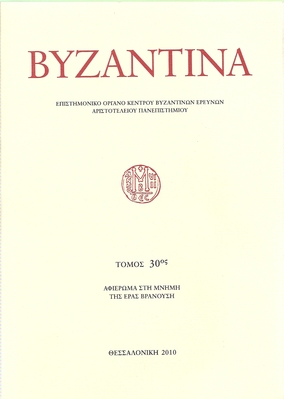Οι κτητορικοί τάφοι στο καθολικό της μονής Ιβήρων
Part of : Βυζαντινά : επιστημονικόν όργανον Κέντρου Βυζαντινών Ερευνών Φιλοσοφικής Σχολής Αριστοτελείου Πανεπιστημίου ; Vol.26, No.1, 2006, pages 125-152
Issue:
Pages:
125-152
Parallel Title:
The founder's tombs in the katholikon of Iviron monastery
Author:
Abstract:
Two funerary arcosolia are found at either end on the west wall of the lite of the katholikon at Iviron Monastery. The southern one has traditionally been considered to be the tomb of the Monastery’s founders, while the northern one used to be regarded as a cenotaph dedicated to Hosios Peter the Athonite and Onufrius of Egypt.The arcosolium at the south end of the liteThe southern tomb is a tall, two-storey structure inside a blind arch, consisting of two built cists, one on top of the other, their front side covered with marble slabs. The top of the upper cist, which nowdays is empty, is covered by a horizontal marble slab, while its bottom is overlaid with a thick layer of plaster.The state of the bottom level is unknown, as it has never been specially searched. It might conceivably be just a compact structure, serving as a pedestal for the upper cist.Two colonettes of Skyros marble stand on either side of the horizontal slab. They have tall, single-block bases, like pedestals, and separate Corinthian capitals made of white marble. Upon these columns rests a white marble arch, adorned on its front side with a relief of an undulating tendril with fiveleaved palmettes.The undulating tendril with palmettes theme, originating in Roman times, is very widely used in Middle Byzantine decorative work. In the 10th and 11th centuries it is principally seen in metalwork such as the bronze door of the Megiste Lavra Monastery on Mount Athos, in the Tantali Kilise (Soganli) murals in Cappadocia (dated 1006-1021), and in sculpture, such as the colonettes of the templon of St. Nicolaus Chapel in Vatopedi Monastery and the plaster ornaments in the same monastery’s main church.The identification of the southern tomb with that of the Founders is unproblematic, as its grandiose two-storey construction agrees with the Life of George the Hagiorite, where it is furthermore stated that the tomb was made by George himself at the start of his abbotship in 1045, for the purpose to housing the relics of the founders Euthymios and John the Iber, as well as those of John Grdzélisdzé and Arsenius.The arcosolium at the north end of the liteAt corresponding spot on the western wall of the north end of the lite is a second arcosolium with a built sarcophagus, whose front side is blocked by an unadorned marble pseudosarcophagus. The arcosoliums’ arched opening is richly framed with plaster relief ornamentation.The tomb was opened on the Monastery’s initiative in 1983 and relics of two persons were found, which Monastery tradition, possibly founded on the Life of Peter the Athonite, identified with Hosios Peter and Onufrius. That hagiographical Life, however, written towards the end of the 10th century by a certain monk Nicolaus of Mount Athos, is not considered as constituting a reliable historical source, unlike the aforementioned Life of George the Hagiorite, whose historical value is unquestioned. The latter text informs us that a marble tomb existed in the left (i.e. north) side of the narthex of the main church, housing the remains of George I, who was abbot from 1019 till 1029 and is referred to as «founder and ornator» of the church. The transfer of his remains to that tomb is conjectured to have taken place under Gregorius’ abbotship (±1035-1041). The same source tells us that following George the Hagiorite’s death, which took place in Constantinople on May 29 of (probably) 1065, his body was transferred to Iviron Monastery and placed into the same sarcophagus as that of George I, meaning that he too, was considered as a new founder. That would explain the presense of a second person’s relics inside the tomb, as discovered in 1983.As far as the ornamentation of the two funerary structures concerned, the tomb of the older Founders’, despite its general monumental character, is rather modestly adorned, with just a relief representing an undulating tendril with palmettes on the marble arch of the front side and Corinthian capitals on the colonettes. On the contrary, there is a much richer relief ornamentation on the plaster archwork of the other tomb’s front side, marked by remarkably diverse geometrical and vegital motifs, executed with exceptional precision and refinement. That ornamentation, closely related to the triple arch (likewise made of plaster) over the cornice of the Imperial Door of the katholikon, constitutes a splendid example of Constantinopolitan decorative art and one that can be dated with reasonable certainty to beginning and in any case before the middle of the 11th century. Furthermore, the circumstance that the two tombs in the katholikon’s lite were not part of the original plan, but were added at a later stage is of particular importance for the history of the churche’s construction. It shows that - at least before the middle of the 11th century - the two arched openings situated at the north and south end of the lite respectively, where the tombs are found, were blocked, and therefore that their filling in must not be connected with the construction or renovation of the outer narthex, which is believed to be a much later addition (from 1513).
Subject (LC):
Notes:
Περιέχει 18 εικόνες




